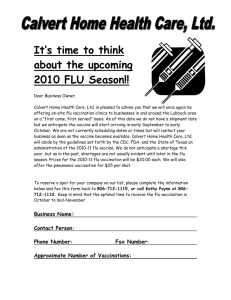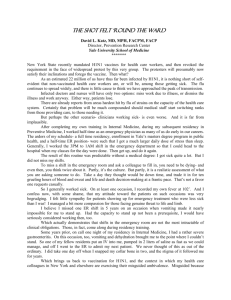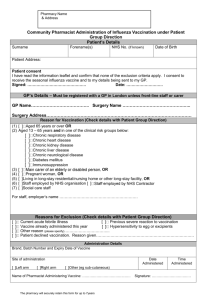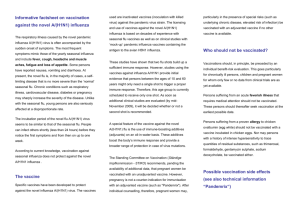Taking H1N1 Vaccination to Vulnerable Populations
advertisement
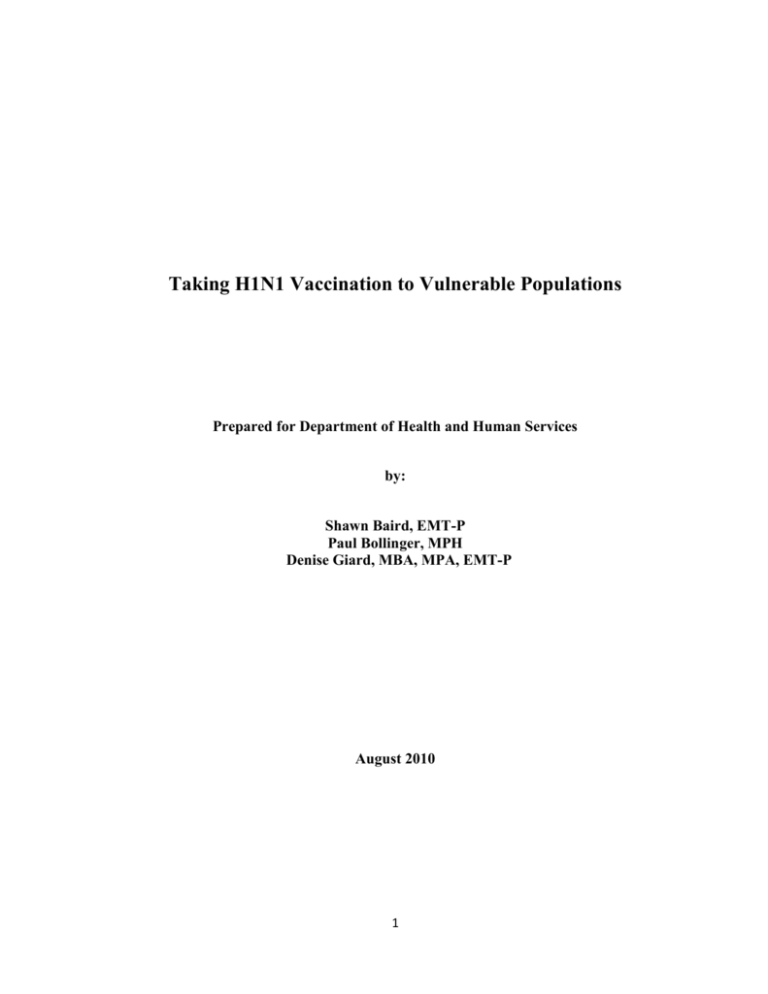
Taking H1N1 Vaccination to Vulnerable Populations Prepared for Department of Health and Human Services by: Shawn Baird, EMT-P Paul Bollinger, MPH Denise Giard, MBA, MPA, EMT-P August 2010 1 ACKNOWLEDGEMENTS This project would not have been a reality were it not for the vision, guidance, and tenacity of Dr. Grant Higginson, MD, MPH who has made significant effort to bridge public health and EMS for the greater public benefit. Jeremy Vankeuren, Project Coordinator Shawn Baird, EMT-P, Oregon State Ambulance Association/Agency Coordinator Toni Grimes, EMT-P, Oregon State Ambulance Association/Agency Operations Coordinator Leadership Team Danielle Bailey, MPH, Shawn Baird, EMT-P, Erin Corrigan, MFA, MPH, Charles Drum, PhD, Lorraine Duncan , Toni Grimes, EMT-P, Grant Higginson, MD, MPH, Tina Kitchin, MD, Robert Leopold, Ritu Sahni, MD, Jeremy Vankeuren, and Donna Weaver. Clackamas County Marti Franc, Clackamas County Health Department Phil Moyer, American Medical Response (AMR) Coos County Tim Novotny, EMT-P Bay Cities Ambulance Frances Smith, Coos County Health Department Jackson County Evelyn Kinsella, Food & Friends Doug Stewart, EMT-P Mercy Flights Patricia Sullivan, RN, BSN Department of Health & Human Services Marion County Toni Grimes, EMT-P Woodburn Ambulance Service Emily McNulty, MPH Marion County Public Health Aaron Monnig, EMT-P Rural Metro Ambulance Multnomah County Erin Corrigan, MFA, MPH Multnomah County Public Health Paul Priest, EMT-P American Medical Response (AMR) 2 ABSTRACT Background The five counties that participated in this project represented over 46% of the total H1N1 patients hospitalized and 34% of the deaths statewide. Vulnerable populations have not had the same access to immunizations as the general population due to mobility, outreach, and communication barriers. Methodology A committee was convened by the Oregon Department of Public Health and determined the project must be supported by: A local advocacy group capable of and supportive of providing outreach A Health Department that was a supportive partner A EMS provider agency prepared to provide the logistics role of providing the immunizations Three models were developed by the health providers for receiving calls and scheduling appointments. Three counties had persons call the EMS dispatch center and schedule appointments. In one county the initial call was received by the State Flu Hotline and then referred to the EMS agency for scheduling. In another county calls were received by the local EMS agency and a coordinator screened and scheduled calls. All five counties followed the same procedure for vaccine administration. Additionally each patient was provided with H1N1 information. Results Seventy individuals met the criteria for vaccination. The post survey results indicated: 55.2% lived alone and were homebound. Over 70% had previously received their influenza 3 vaccine from their healthcare provider. 38.9% were not previously vaccinated due to vaccine availability. Incidentally 80% received their public health information via the television. The partner organizations were also surveyed. Findings indicated that relationships between the EMS agencies and the local health providers were greatly enhanced. All agreed that participation would be higher during the influenza season. Conclusion Public health and EMS should actively seek out opportunities to jointly participate in routine community health ventures in order to build a solid relationship in the event of future health emergencies. 4 TABLE OF CONTENTS Acknowledgments……………………………………………………………………………..2 Abstract………………………………………………………………………………………..3 Table of Contents……………………………………………………………………………...5 List of Figures…………………………………………………………………………………6 List of Tables………………………………………………………………………………….6 Introduction……………………………………………………………………………………8 Methodology…………………………………………………………………………………..9 Results………………………………………………………………………………………..12 Vaccine Administration………………………………………………………………….12 Assessment of EMS Patient Survey……………………………………………………...15 Stakeholder Debriefs……………………………………………………………………..27 Discussion……………………………………………………………………………………31 Recommendations……………………………………………………………………………32 References……………………………………………………………………………………33 Appendices Appendix A: Appendix B: Appendix C: Appendix D: Workflow Project Resource Manual FAQ for Nutrition Program Volunteers H1N1/EMS Patient Survey 5 Appendix E: Preparing Yourself - How to plan for H1N1 flu and other emergencies Appendix F: Stakeholder Debrief Sessions 6 LIST OF FIGURES Figure 1: County of Residence……………………………………………………………..14 Figure 2: Patient Gender……………………………………………………………………15 Figure 3: Patient Race……………………………………………………………………...15 Figure 4: Living Situation………………………………………………………………….16 Figure 5: Consider yourself homebound…………………………………………………...16 Figure 6: Specific Type of Disability………………………………………………………17 Figure 7: Received vaccine in past five years……………………………………………...17 Figure 8: Where was vaccine received..................................................................................18 Figure 9: What stopped you from being vaccinated.............................................................19 Figure 10: Do you have enough food and water for three days..............................................20 Figure11: Would you need assistance in a shelter..................................................................21 Figure 12: Do you have a designated person that can assist you during a disaster.................22 Figure 13: Do you have an emergency plan............................................................................23 Figure 14: If yes, what is your plan.........................................................................................24 Figure 15: Where did you get information last fall on the H1N1 flu......................................25 Figure 16: How do typically get public health information....................................................25 Figure 17: What is the best way to get public health information to you...............................26 7 LIST OF TABLES Table 1: Single Individual Vaccination……………………………………………………12 Table 2: Multiple Individuals Vaccinated…………………………………………………13 8 INTRODUCTION Every year, 5% - 20% of the American population falls ill with influenza and on average 36,000 persons die from influenza-related complications. 1 The H1N1 2009 influenza pandemic resulted in over 209,000 laboratory-confirmed cases and over 3,205 deaths worldwide as of September 11, 2009. 2 Oregon flu statistics indicate that between the start of the pandemic in late April and August 2009, there were 116 Oregonians from 11 counties hospitalized and 12 deaths. September 1, 2009 through May 1, 2010 recorded 1,314 additional patients hospitalized with influenza resulting in 67 deaths. 3 The percentage of deaths from the H1N1 2009 influenza in Oregon at 5.5% is significantly higher than the worldwide average of 1.53%. The five counties chosen to participate in this project represent over 46% of the total patients hospitalized and 34% of the deaths. It has been proven that immunizations reduce illness and death from influenza and respiratory tract infections that result from underlying influenza. Seasonal influenza immunization rates among the elderly, the population that account for 90% of influenza-related deaths, raised steady for a number of years, but have now leveled off at between 50 and 70%. 4 Vulnerable populations have not had the same access to influenza immunizations and the H1N1 vaccination as the general population due to mobility, outreach, and communication barriers. Vulnerable populations, targeted for this project, included home-bound seniors and people with disabilities. The project hopes to prove that by utilizing non-traditional vaccinators, 1 2 3 4 www.nyam.org/initiatives/docs/june1109_testimony_h1n1preparedness.pdf www.ncbi.nlm.nih.gov/bookshelf www.flu.oregon.gov/articles/Pages/FluStats www.nyam.org/initiatives/doc/june/1109_testimony_h1n1preparedness.pdf 9 specifically paramedics affiliated with local ambulance services, an effective strategy for improving immunization rates will be established. The “Taking H1N1 Vaccination to Vulnerable Populations” project hopes to demonstrate that the state’s public health system in partnership with ambulance services can: 1. Use community-based organizations serving people with disabilities and seniors to identify unvaccinated vulnerable individuals in their community. 2. Rapidly deploy a cadre of vaccinators outside of routine public health system resources who can vaccinate vulnerable individuals, primarily in their homes. 3. Strengthen Emergency Medical Service (EMS) agencies participation in public health emergency response efforts. 4. Improve collaboration amongst EMS agencies, community-based organizations and local health departments. METHODOLOGY Planning In January 2010 the Oregon Department of Human Services Public Health Division (DHS PH) contacted the Oregon State Ambulance Association (OSAA) to discuss the potential for partnership in piloting a project to administer H1N1 vaccination to vulnerable/homebound persons. EMS agencies and the paramedics they employ would serve as mobile providers administering vaccines to homebound recipients. DHS PH formed an initial steering committee in early February which included the OSAA President, State EMS Director, State EMS Medical Director, State Immunization 10 Coordinator, and DHS PH Community Health Director. After considerable discussion, the group developed the scope of work to a manageable project given the short timeline and tight budget. The committee decided that the likelihood of success would be realized if all elements resembling a “three legged stool” were in place: 1. An EMS provider agency ready and prepared to take on the role of scheduling vaccinations and deploying paramedics to provide the immunization, 2. The local Health Department that was an enthusiastic partner in the concept of the project, and 3. A local advocacy group capable of and supportive of providing outreach to an eligible vulnerable/homebound population. Considering Oregon’s 36 counties the committee quickly narrowed down the list to 10. Each of the three component agencies was contacted in those areas for preliminary discussion of interest in the project. If any one component was felt to be not ready or not interested to do the project that county was struck from the list. Five counties were selected after meeting all requirements of the “three-legged stool”. Recognizing a need for a more comprehensive approach to the project, additional stakeholders were added to the strategy building sessions. The “Leadership Team”, was comprised of representatives from county health departments, Seniors and Persons with Disabilities (SPD), Oregon Health Science University, OSAA, DHS PH and a project coordinator. The expanded group became the core work team for project development from this point forward. The group decided on a general approach from which the OSAA built a workflow (Appendix A) demonstrating the process from marketing through administration. County work 11 teams were established with representatives from the ambulance service, county health department, SPD advocate, OSAA and DHS PH. The county teams held bi-weekly conference calls to assure that planning goals were met in the weeks leading up to implementation. From the March 31st, date of signature on the project contract, to the first immunization approximately four weeks passed during which all operational level planning and training took place. Process OSAA assigned a project coordinator who assembled a complete project agency resource manual (Appendix B) covering all technical details for EMS agencies and paramedics to follow. This was done to assure a baseline knowledge level of the project and implementation details. Information about physical facility requirements for vaccine storage and transport, paperwork, and refresher video training on vaccine administration was included among other topics. In the week prior to the first vaccine administration, the OSAA coordinator met with each EMS provider agency to review the handbook and all ancillary materials. In addition, a site visit was conducted to verify proper vaccine storage equipment was available, temperature controls were being adhered to, and log book instructions were comprehended. The EMS agency representative outlined the specific workflow that they would follow from receipt of a call from an interested patient through the administration and completion of all ALERT and survey paperwork can be found in Appendix B. These site visits provided opportunity for questions to be raised and resolved prior to the start date of vaccinations. Procedure Community based organizations, primarily ‘Meals-on-Wheels’ or similar facsimile, were identified by SPD to distribute FAQ Sheet (Appendix C) to their homebound clients notifying 12 them of the program and how to contact their local ambulance provider to schedule a vaccination visit. Three separate models were utilized by EMS agencies for receiving calls and scheduling appointments. Clackamas, Jefferson and Coos County had interested persons call their dispatch center and the call taker scheduled appointments. In Multnomah County the initial call was received by the State of Oregon Flu Hotline and then referred to the EMS agency for scheduling. In Marion County calls were received by the business office of the EMS agency and a paramedic coordinator returned the calls for screening and scheduling. Call takers, in each model, conducted a brief screening determining medical eligibility prior to sending EMT’s on long drives to rural areas. After scheduling the appointment all five counties followed the same procedure, sending a paramedic to the residence where the ALERT paperwork was completed, screening questions asked, and vaccine administered. During the 15 minute wait period, to assure there was no reaction to the vaccine, the paramedic completed a survey (Appendix D) with each patient. Additional information was compiled in a pamphlet titled “Preparing Yourself- How to plan for H1N1 flu and other emergencies” and was distributed to each patient (Appendix E). At the conclusion of the home visit the paramedic would complete entries into the log book, including in route times, arrival, location, and mileage. RESULTS The results of the collaborative effort may be reviewed in three distinct parts. The success of the actual scheduling and process of vaccinations, the information about the patient population that was reached and the general impressions of the vaccination teams and stakeholders involved. Vaccination Administration 13 Paramedics were required to log in ‘Time of Departure’, ‘Arrival at Vaccination Location’, ‘Departure from Vaccination Location’, and ‘Arrival back at EMS Agency’. Total miles traveled were logged for each vaccination. This log allowed us to analyze the total time on task for a vaccination, total miles driven, and the time actually spent in a home with a patient. The data was further refined by separating out incidents in which a single individual was vaccinated, compared to incidents in which multiple persons in one home were vaccinated. The following tables illustrate total amount of time on task for a paramedic from departure to return to their station. Time on scene includes: time of arrival, greeting the patient, performing medical screening, administering the vaccine, and completing the patient survey during the recommended 15 minute wait time for assuring no adverse reaction to the vaccine. Tables 1 & 2 compare the difference in time on scene when only one patient is vaccinated versus more than one in a single visit. Table 1: Single individual vaccination given in home. N= 58 Total Time Time on Scene Total Mileage AVG. 45.10 29.38 8.76 MIN. 20 15 0 MAX. 77 58 44 MED. 42 29 4.6 MODE 40 30 3.8 14 On average, from start to finish, the paramedic was dedicated to the task of providing a vaccination for 45.1 minutes, traveling 8.76 miles and spending 29.38 minutes on scene with the patient. This time includes the completion of the non-scannable ALERT form and screening questions, actual vaccine administration, review of disaster preparedness materials, and patient survey completed. Table 2: Multiple individuals vaccinated in one home N=22 Total Time Time on Scene Total Mileage AVG. 54.04 37.43 37.43 MIN. 30 25 25 MAX. 70 58 58 MED. 57 35 5 MODE 60 25 25 In these cases more than one person in a household was vaccinated. The total number of vaccinations in the multiple household averaged 2.1 persons. On average the total time was 54.04 minutes. The time on scene was an average of 37.43 minutes. This is about 8 minutes longer than the scene time for one individual. Thus doubling the number of vaccinations per household only added an extra 17% of time to the process. 15 Patient Population Survey Paramedics interviewed patients from a survey form (Appendix D) following administration of the vaccine. The following graphs indicate the responses from H1N1 Project Survey Results. Respondents of the survey ranged in age from range 42 to 99, with a median age of 75. Figure 1: County of Residence Jackson County administered the greatest number of vaccinations. This may be due to the fact that they were able to accomplish news media coverage including television locally. 16 Figure 2: Patient Gender Figure 3: Patient Race 17 Figure 4: Living Situation Figure 5: Consider Yourself Homebound? 18 Figure 6: Specific Type of Disability Figure 7: Received Vaccine in Past Five Years 19 Seven percent indicated they had not received a flu shot in any of the last five years; however despite being homebound 54% indicated they receive their flu shots annually. Figure 8: Where have you received your flu vaccine in the past? 20 Figure 9: What stopped you from being vaccinated for H1N1 initially? The lack of availability of vaccine presented the greatest single barrier to the surveyed population. Twenty-four percent reported homebound status and lack of assisted transportation as the primary reason for not obtaining vaccinations. 21 Figure 10: Do you have enough food and water for three days? Ninety-three percent indicate that they have adequate resources to sustain themselves for three days. The survey did not get into specifics with regards to needing additional assistance during that three day period, or if there was a true understanding of a three-day supply. Would that same answer apply if the power was out and water and refrigeration impacted their three-day supply? 22 Figure 11: Would you need assistance in a shelter? Twenty-seven percent of respondents indicated they would need assistance to complete personal tasks in a sheltered situation. The remaining 72.9% thought they would do just fine in a sheltered situation without any assistance. 23 Figure 12: Do you have a designated person that can assist you during a disaster? An alarming concern for emergency responders is that over one-third of the survey recipients have no one to assist them in time of disaster. 24 Figure 13: Do you have an emergency preparedness plan? 25 Figure 14: If yes, what is your plan? Forty-eight percent of respondents report that they did not receive information on how to protect themselves from H1N1. The following two graphs indicate that television is the favored means of receiving noteworthy news and information on health related emergencies. 26 Figure 15: Where did you get information last fall on the H1N1 flu? Figure 16: How do you typically get public health information? 27 Figure 17: What is the best way to get public health information to you? Stakeholder Debrief Sessions At the conclusion of the vaccination administration phase participating agencies in each County jurisdiction was debriefed. Information was obtained from two on-site small group meetings, one meeting in the Portland area incorporating teleconference capabilities, and the remaining feedback was obtained via email. Each group provided feedback to the project, process and outcome by responding to four questions: 1. How did the project go from your point of view? 2. What went well? 3. What, if any, challenges or concerns were experienced? 28 4. What would your recommendation for changes be if a similar project were to be undertaken in the future? The response from participants was phenomenal and can be found in Appendix F. Analysis of the responses centered on four themes; management/coordination, timing, resources, and information. Management/Coordination Assigning a Project Coordinator, at the state level, was recognized by all as key to the management and coordination of the project. Assignment of roles and responsibilities was instrumental to each county functioning within their local areas and reporting back to a central core group. The development of teams at the local level proved to be extremely successful and fostered initial and on-going communication throughout the process. Relationship building amongst diverse work groups in alternative disciplines was seen as a strong benefit to this process. Coos, Jefferson and Marion County’s participating agencies seemed to possess strong working relationships due to on-going committee participation and previous projects that have been collaborated on. The H1N1 project seemed to aid and foster coordinated working relationships. A consistent theme was each of the stakeholders felt that they should have been brought into the planning process earlier. Due to the nature of the project development it would have been very difficult to get off the ground in the steering committee was too large and cumbersome to manage. The process of bringing in additional stakeholders occurred as needs were identified. Positive working relationships will be extremely beneficial in ensuring personnel needs and resources will be realized in a timely manner in the event of an emergency. Timing In every debriefing session the timeliness of the project was brought into question. 29 Overall results of the numbers vaccinated would have been significantly higher had the project been implemented during the flu season. Many had already received their vaccinations either from their personal physicians or through sponsored clinics. The demand for the vaccine had already passed by the time this opportunity presented itself. Comments like “no need for thisthe disease activity had already dropped off” or “this would have been more beneficial earlier on” seemed to resonate amongst all participants. In another aspect of timing was the concern about how long this project seemed to take to get off the ground. The extended delay in receiving notification that funding for the project was available meant that the vaccinations were being conducted well after the public had stopped being concerned about H1N1 influenza. This significantly reduced the participating population. As soon as notification was made that funding had been secured then agreements could be put in place, advertising and printing could be established and the project could proceed. Many agencies were not able to commit to even the planning until they knew that funding was available to support their participation in the project. It was also discovered that many did not have contractual or response agreements in place and the timing to achieve legal agreements amongst all parties further delayed the implementation date. Not all parties found the delay to be detrimental, in fact, the Operations Coordinator used the time to develop a complete instruction manual entitled “BVVP Project - Agency Resource Manual” (Appendix B), to facilitate step-by-step instruction to participating EMS agencies and the paramedics providing the vaccinations. Resources Participation in this project was contingent upon outside funding. Most, if not all, of the 30 organizations involved in this project would not have been able to participate if funding was to be supported from within their current budgets. Additional financial resources were necessary to pay for personnel, advertising, training, equipment and supplies. The distribution of resources was called into question. Some participants expressed that they believed that the program would have been implemented much quicker and more efficiently if the state had distributed the money to each region or county. Pairing local funding with the resources provided through this grant would have afforded many areas to achieve a better bang for the buck. Others questioned whether this was a good use of the resources, providing free vaccines to a limited number of individuals at a very high per unit cost. Would it not be better to provide those same resources to a larger population base in a clinic setting at a free or reduced cost per patient? Home delivery by a nurse or paramedic is not a cost effective mode of delivery. The recipients of the free vaccine were very appreciative, however many were skeptical needing further explanation in order to participate. Providers expressed the concern of whether we may have set a precedent in providing the vaccine free. Did we establish the expectation that if they wait the County will provide it for free after the initial impact of flu season is past? Information Advertising for this project and the information provided to the intended recipients of the vaccine seemed to be confusing to many. Initially, when the H1N1 potential pandemic was upon us, many of the seniors and disabled persons were told they were not within the high risk category and did not need to get the vaccine unless they had an identified medical condition. The H1N1 Vaccination to Vulnerable Populations project was in complete opposition to the original message. Why now am I in need of the vaccine when I wasn’t before? Also confusing 31 was that this particular vaccine would not provide protection for the upcoming flu season and that recipients of the vaccine would need to still obtain another flu shot next fall. Advertising mediums varied by jurisdiction. The State did develop and provide the initial brochure/flyer to be used during this project. The innovative approaches of distribution of the flyers through ‘Meals-on-Wheels’, ‘Food for Friends’, ‘Council of Governments’, or ‘Agency on Aging’ was noted as extremely resourceful and would most likely be used in future distributions of information. In addition, each County also developed advertising specific to their community. Posters, flyers, commercials for local television, radio advertising or appearing as a guest during a daytime talk show, featured news stories, and public service announcements (PSAs) all contributed to the message getting out and the intended participants being notified. Of significant concern and causing great frustration to County Health Departments was dealing with the State’s data system. The state data system was not designed to extract specific data nor be compatible with other systems. It was not possible to use the system to identify specific mailing addresses and determine who in a specific county had already been vaccinated. This made it much more difficult to identify the target population. DISCUSSION The project demonstrated that utilizing paramedics and ambulance services to vaccinate homebound/vulnerable populations is an effective way to reach an otherwise difficult to access patient population. Paramedics, Public Health, and community based organizations completed all phases of the project without complication. The patient enrollment numbers would have been significantly higher were it not for Inherently slow bureaucratic process at the federal and state agencies overseeing the grant funding for this project. The final contract implantation date was far too late in the H1N1 32 pandemic cycle to realize the enrollment initially anticipated. The need for vaccination was significantly reduced in the eyes of most potential patients, media, and health professionals. A determining factor in the successful implementation of the project was the existence of pre-existing strong relationships between public health and ambulance services. In those areas of the state where relationships of mutual respect and an accurate understand of each other’s roles and responsibilities was present the project was able to quickly mobilize and become operational. RECOMMENDATIONS Paramedics and ambulance services should continue to work collaboratively on community health initiatives. Paramedics should have a role in providing routine and emergency influenza vaccination when appropriate to the local situation. Public health and EMS should seek out opportunities to jointly participate in routine community health ventures in order to have built a solid relationship which will greatly enhance their ability to work together in the event of future health emergencies. 33 REFERENCES Institute of Medicine. (2009). The Domestic & International Impacts of the 2009 – H1N1 Influenza Pandemic. The National Academies Press. www.ncbi.nlm.nih.gov Ompad, Danielle & Bond, Keosha. (2009, June 11). New York City’s Response to H1N1 & Influenza Preparedness. http://www.nyam.org/initiatives/doc/june1109_testimony_h1n1preparedness.pdf Oregon Public Health. Flu Statistics. July 19, 2010. http://www.flu.oregon.gov/articles/Pages/FluStats.aspx 34 35
